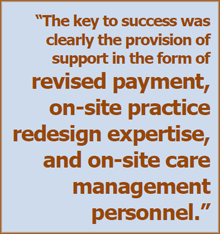Synopsis
Small, underresourced primary care practices can rapidly transform into medical homes if they receive external support, including hands-on expertise in practice redesign, assistance with care management, and enhanced payment. To ensure access to this support, health care organizations and state policymakers might consider creating a "public utility" to contract out medical home support services to physician practices.

The Issue
There is a growing body of evidence showing that the patient-centered medical home can improve health outcomes while reducing costs. But there is concern that solo and other small physician practices—which make up a sizable proportion of all U.S. primary care practices—may lack the capacity and experience needed to fully implement the medical home model. This Commonwealth Fund–supported evaluation tested the impact of providing small practices with external support for the transition to a medical home, including help with practice redesign and care management and increased reimbursement. Progress was assessed through the National Committee for Quality Assurance’s (NCQA) Physician Practice Connections—Patient-Centered Medical Home recognition program, which evaluates practices on nine medical home standards.
Key Findings
- When measured at baseline, only three of the 20 intervention practices (15%) and none of the 14 control practices had achieved any level of medical home recognition.
- After 18 months, 16 intervention practices (80%) reached level 3 recognition—NCQA’s highest level. One (5%) reached level 2 recognition, while two (10%) achieved level 1 recognition.
- After 18 months, only one intervention practice (5%) had not achieved any level of medical home recognition, compared with 11 control practices (79%).
- Over 18 months, intervention practices showed significant improvement on eight of the nine standards used by the NCQA to assess medical homes. One standard—using advanced electronic communications—remained a barrier for both intervention and control practices.
- Intervention practices changed much more quickly during the first seven months of the trial than during the subsequent 12 months.
Addressing the Problem
The findings suggest that small practices, if provided with significant external support, can become medical homes within a short time frame. Accountable care organizations, state agencies, and others might consider centralizing medical home support services under a "public utility," with services contracted out to practices during the transition period. Efforts to implement the medical home model should focus in particular on electronic prescribing, referral tracking, and advanced electronic communications.
About the Study
Emblem Health, the largest insurer in New York State, led a randomized, controlled trial of medical home implementation among solo (less than two providers) and small (two to 10 providers) practices. Intervention practices received external support, including 18 months of assistance with practice redesign, 18 months of support from nurse care managers embedded at the practices, and two years of revised payment, which covered the cost of applying for NCQA medical home recognition and provided for pay-for-performance bonuses. The 14 control practices received annual payments for participation in the trial plus reimbursement of the cost of applying for NCQA recognition. Independent process and outcome evaluation was conducted by researchers at the University of Connecticut.
The Bottom Line
Even the smallest primary care practices can rapidly become medical homes when provided with significant external support, including on-site help with practice redesign, care management, and additional payment. Without such support, change is likely to be slow and limited in scope.


